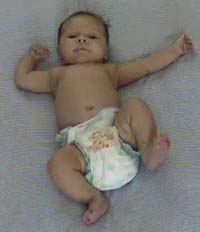Typically developing infants are very busy
They are on the move and exploring most of their waking moments from a very young age
Very young babies spend a lot of time watching – they kick and wave their arms at nearby toys. When they are being held and moved they lift up their heads and look around. They push against their carers, grab and hold on. They pick up, rattle, throw, pull push toys and everyday objects that they can reach.



Once the child is crawling and walking they cover large distances each day under their own steam. They follow carers, go after toys, reach for out-of reach objects, open doors and drawers, clamber up onto sofas, climb up onto the table, push chairs around to name just a few ways of exploring their environment.


All this action makes the child fitter and adds to their ability to explore and find out how their bodies work.
Children who are not developing in the usual way are often less active
They may wait for things to come their way, do not reach out and explore in the same way. This means that their muscles are not getting stronger and their experience is not rich.
What can be done to remedy this situation?
The trick is to adapt the social and physical environment in a way that invites the child to be active and gives him or her lots of experience in achieving and succeeding. The old adage success breeds success is very true for children.
Adapting the environment to invite action is not difficult – or even particularly time consuming. It just takes a little thought and some practical ideas. After all, your baby or child is in the presence of a carer most of his or her waking day.
How May's parents created a rich and supportive environment for learning
May, who is one of a twin is 9 months old. She was born 6 weeks preterm and small for date, so her corrected age is actually 71/2 months. Typically developing children learn to sit between 6 and 8 months. Preemies may be a month or so later.
Her twin sister Jane is very busy, crawls everywhere at speed and is starting to pull up into standing. Up until recently May has been happy to sit in her bouncy chair and watch her sister move around, but recently she seems to be getting very frustrated and seems to want to follow her sister.
May can sit on her own, but topples over quickly. She does not like being on her tummy – complains and rolls onto her back. She can roll over from her back to her tummy but has not yet discovered that if she rolls over and over she can move across the room.
Here are some of the things her parents now do to encourage her to be more active
When she sits on her mom or dad’s lap, she tends to lean into them using them to support her trunk. Now her parents are encouraging her to reach out for toys so that she is more active. They also gently tip her in different directions to force her to steady her trunk.


Dad likes to toss his girls up into the airs and dance around with them. May loves the attention but gets very upset if dad gets a bit too enthusiastic. Now her dad has leant how to push her boundaries a little each time he plays with her so that she is getting braver and learning to hold her head steady as she is moved around.
When she is being carried from place to place, her parents make sure she is not fully supported and has to work to keep her trunk erect. This is a great opportunity to strengthen her back and tummy muscles.
Each time her nappy is being changed, her parents do some tummy exercises to get her stronger. They play foot tickle exercises to encourage her to lift up her legs, and also pull her up from lying into sitting slowly so that she has to work her neck and tummy muscles hard.
The family have made some special time for tummy time activities – and slowly but surely May is learning to push up onto her hands and knees. Read more How to teach an infant to get up onto all fours.


Her parents have also learnt how to support her in sitting so that when she does topple over, she can bring herself upright again. She now enjoys playing in a sitting position, reaching for toys and finding our how to keep her balance. For subscribers: Learning to balance in sitting

Her parents have also been given a lot of ideas for making toys from everyday materials to supplement the bought toys and ensure that there is always something new and interesting to keep May active and busy.
May is a lot happier now; she has discovered the joys of extending herself and succeeding at many new tasks. May’s parents have been very good about taking ideas and incorporating them into the daily routine.
This has not been easy because May’s twin Jane also needs to be included in the games and activities. Twins are always hard work, when one twin needs extra attention it makes it very hard.
However, understanding the children’s developmental needs has made it easier for the parents to adapt their environment to suit the needs of each twin.
